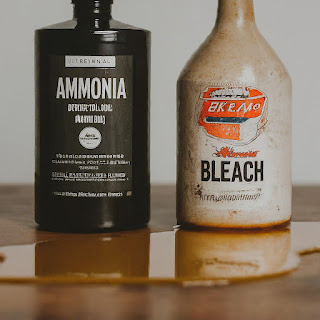Mixing household chemicals is a common practice, but it can lead to dangerous reactions if you're not careful. Two such chemicals that should never be combined are bleach and ammonia. Understanding why this mixture is hazardous involves exploring the chemical reactions and potential health risks. This article delves into what happens when you mix bleach and ammonia, the dangers involved, and how to handle these substances safely.
 |
| Don't let these two meet. They're a dangerous duo. |
The Chemistry Behind Bleach and Ammonia
1. Bleach:
Bleach, typically sodium hypochlorite (NaOCl), is a powerful disinfectant and whitening agent commonly used in household cleaning products. It works by releasing chlorine, which is an effective agent for killing bacteria, viruses, and fungi. The chemical formula of sodium hypochlorite is:
2. Ammonia:
Ammonia, or ammonium hydroxide (NH₄OH) when in solution, is a strong base used in various cleaning products. It is effective at cutting through grease and grime. The chemical formula of ammonia in its common aqueous form is:
Chemical Reaction Between Bleach and Ammonia
When bleach and ammonia are mixed, a chemical reaction occurs that produces several toxic compounds. The primary reaction can be summarized as follows:
In this reaction, sodium hypochlorite reacts with ammonia to form chloramine (NH₂Cl) and sodium hydroxide (NaOH). Chloramine is a group of chemicals that includes monochloramine, dichloramine, and trichloramine. The exact type of chloramine formed depends on the concentration and ratio of bleach to ammonia.
The Dangers of Chloramine Gas
Chloramine gases, including monochloramine (NH₂Cl), dichloramine (NHCl₂), and trichloramine (NCl₃), are extremely hazardous. Here’s why:
1. Toxicity:
Chloramines are highly toxic and can cause severe respiratory irritation and damage. Exposure can lead to symptoms such as coughing, wheezing, shortness of breath, and chest pain. In severe cases, it can lead to pulmonary edema, which is a condition where fluid accumulates in the lungs and can be life-threatening.
2. Corrosiveness:
Chloramines are corrosive to the respiratory tract and can cause irritation and damage to mucous membranes, eyes, and skin. Prolonged exposure can lead to chronic respiratory issues and other health problems.
3. Reactivity:
Chloramines are reactive and can further decompose into other harmful substances. For instance, trichloramine is known for its strong odor and is often associated with “pool smell” in indoor swimming pools, which can also be irritating.
Health Risks and Symptoms
The immediate symptoms of exposure to chloramines include:
- Respiratory Issues: Shortness of breath, wheezing, coughing, and throat irritation.
- Eye and Skin Irritation: Redness, itching, and burning sensations.
- Headaches and Nausea: Often accompanied by dizziness and general malaise.
In severe cases, exposure can result in long-term respiratory damage and chronic health conditions.
Safety Precautions
To prevent dangerous reactions, follow these safety precautions:
Never Mix: Avoid combining bleach with ammonia or any products containing ammonia. Always read product labels for warnings and instructions.
Ventilation: Ensure good ventilation when using these products separately. Open windows and use fans to disperse fumes.
Protective Gear: Wear gloves and eye protection when handling bleach and ammonia. Consider using masks if ventilation is inadequate.
Emergency Response: If accidental mixing occurs, leave the area immediately and get fresh air. If symptoms persist or if you suspect exposure to toxic gases, seek medical attention promptly.
Proper Storage: Store bleach and ammonia in separate locations and ensure they are securely closed to avoid accidental mixing.
Conclusion
Mixing bleach and ammonia can lead to the formation of toxic chloramine gases, posing significant health risks. Understanding the chemistry behind this reaction and taking appropriate safety measures are crucial in preventing dangerous exposures. Always handle cleaning chemicals with care, and prioritize safety to avoid hazardous situations.




0 Comments